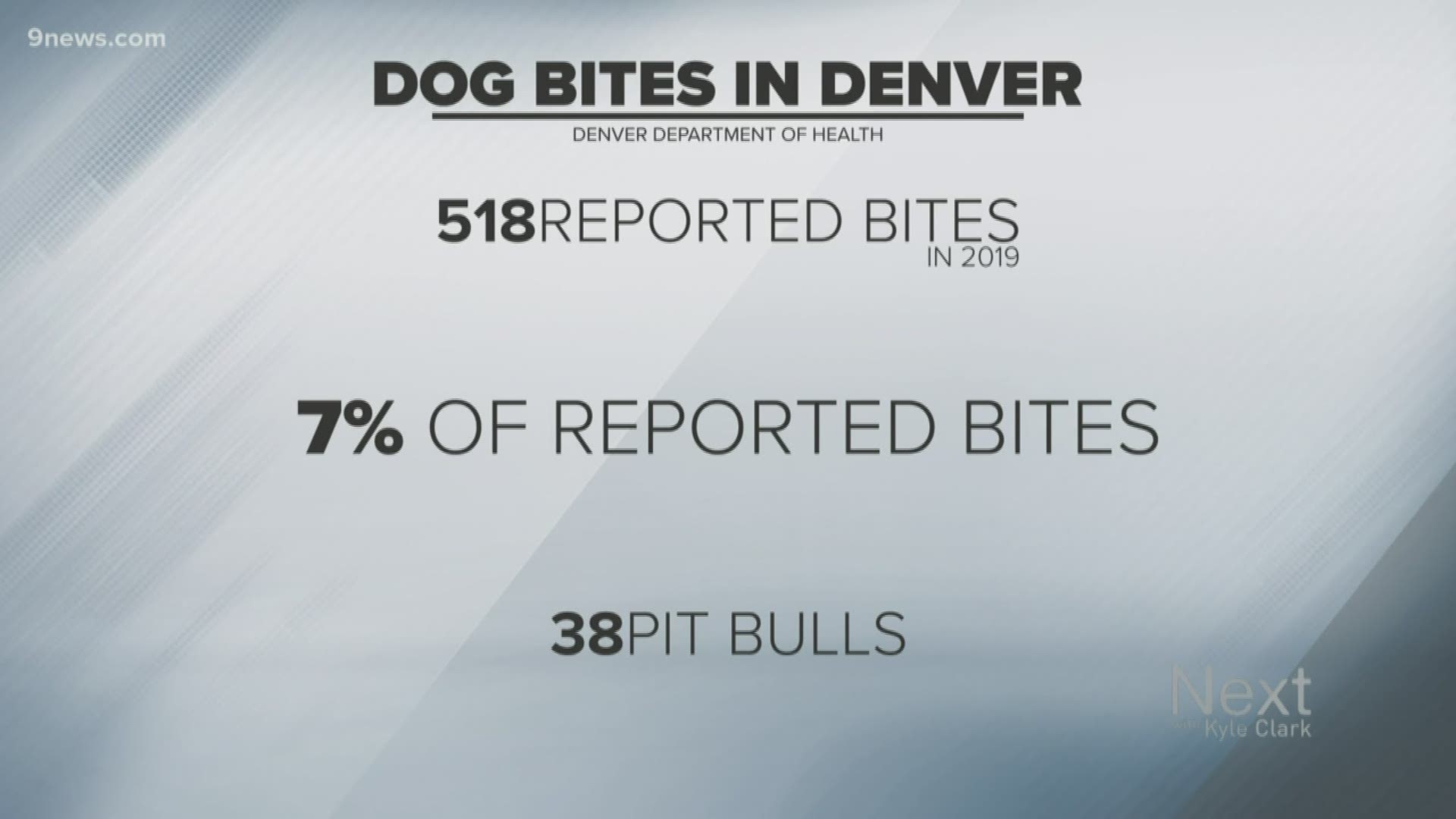DENVER — There are pit bulls in Denver.
Legally, people living in Denver are not permitted to own dogs that are classified as pit bulls. The city council attempted to overturn a decades-old breed ban last week, but Mayor Michael Hancock vetoed the resolution.
Still, the city’s dog bite statistics from 2019 show about 7% of incidents involved pit bulls, and the most serious reports name pit bulls more than any other breed.
The number of pit bull bites ranks a few percentage points above the total from the past decade. The Denver Department of Public Health and Environment (DDPHE) said there have been 253 pit bull bites since 2010. The total number of dog bites during that time was 5,721, meaning pit bull bites accounted for about 4.4%.
Pit bulls rank fifth of the list for most dog bites in 2019. The top breed for dog bites last year? Labrador retrievers.
NUMBERS BY BREED
DDPHE tracks dog bites. People reported a total of 518 dog bites in 2019. Here's the breakdown by breed:
- LABRADOR RETRIEVER: 54 (10%)
- GERM SHEPHERD: 49 (9%)
- UNKNOWN DOG: 42 (8%)
- AMERICAN BULLDOG: 41 (7%)
- PIT BULL: 38 (7%)
- AUSTRALIAN CATTLE DOG: 27 (5%)
- SIBERIAN HUSKY: 23 (4%)
- CHIHUAHUA (SHORT HAIR): 18 (3%)
- BORDER COLLIE: 16 (3%)
- BOXER: 15 (2%)
- BULL TERRIER: 13 (2%)
- ROTTWEILER: 12 (2%)
- ENGLISH BULLDOG: 10 (1%)
- SHIH TZU: 10 (1%)
- WEST HIGHLAND TERRIER: 10 (1%)
- BEAGLE: 8 (1%)
- AUSTRALIAN SHEPHERD: 6 (1%)
- MASTIFF: 6 (1%)
- MINIATURE POODLE: 6 (1%)
- CHIHUAHUA (LONG HAIR): 4 (0%)
- CHINESE SHAR PEI: 4 (0%)
- CHOW CHOW: 4 (0%)
- DACHSHUND: 4 (0%)
- DOBERMAN PINSCHER: 4 (0%)
- GERMAN SHORTHAIRED POINTER: 4 (0%)
- Others: 90 (17%)
SEVERITY OF DOG BITES
The city categorizes bites by severity on a scale ranging from Level 2, on the low end, to Level 5, on the high end. The greatest number of attacks in 2019 were categorized as Level 2.
- LEVEL 2: Contact with the skin without puncture, or, at most, a shallow puncture with slight bleeding
- LEVEL 3: One to four punctures from a single bite, with no puncture deeper than half of the dog's canine tooth. There may be a laceration from the dog or person pulling away
- LEVEL 4: One to four punctures from a single bite with at least one being deeper than half the length of the dog's canine tooth. May include bruising if dog bore down, and may include lacerations in more than one direction
- LEVEL 5: Multiple bites with at least two Level 4 bites
LEVEL 2:
- GERMAN SHEPHERD: 18 (8%)
- UNKNOWN DOG BREED: 14 (6%)
- AUSTRALIAN CATTLE DOG: 13 (6%)
- AMERICAN BULLDOG: 12 (5%)
- LABRADOR RETRIEVER: 12 (5%)
- CHIHUAHUA: 11 (5%)
- SIBERIAN HUSKY: 11 (5%)
- BORDER COLLIE: 10 (4%)
- PIT BULL: 10 (4%)
- BOXER: 7 (3%)
- Others: 89 (42%)
TOTAL: 207
LEVEL 3
- LABRADOR RETRIEVER: 23 (14%)
- GERMAN SHEPHERD: 18 (11%)
- AMERICAN BULLDOG: 13 (8%)
- PIT BULL: 12 (7%)
- AUSTRALIAN CATTLE DOG: 10 (6%)
- UNKNOWN DOG: 8 (4%)
- BULL TERRIER: 6 (3%)
- ROTTWEILER 6 (3%)
- BEAGLE: 5 (3%)
- CHIHUAHUA: 5 (3%)
- Others: 55 (34%)
TOTAL: 161
LEVEL 4
- LABRADOR RETRIEVER: 13 (18%)
- AMERICAN BULLDOG: 10 (14%)
- GERMAN SHEPHERD: 8 (11%)
- PIT BULL: 5 (7%)
- SIBERIAN HUSKY: 4 (5%)
- AUSTRALIAN CATTLE DOG: 3 (4%)
- BOXER: 3 (4%)
- CHOW CHOW: 3 (4%)
- BULL TERRIER: 2 (2%)
- GOLDEN RETRIEVER: 2 (2%)
- Others: 16 (23%)
TOTAL: 69
LEVEL 5
- PIT BULL: 4 (36%)
- AMERICAN BULLDOG: 3 (27%)
- AUSTRALIAN CATTLE DOG: 1 (9%)
- DOGO ARGENTINO: 1 (9%)
- LABRADOR RETRIEVER: 1 (9%)
- OLD ENGLISH BULLDOG: 1 (9%)
TOTAL: 11
UNKNOWN LEVEL
- UNKNOWN DOG: 18 (25%)
- PIT BULL: 7 (10%)
- GERM SHEPHERD: 5 (7%)
- LABRADOR RETRIEVER: 5 (7%)
- SIBERIAN HUSKY: 4 (5%)
- AMERICAN BULLDOG: 3 (4%)
- WEST HIGHLAND TERRIER: 3 (4%)
- AUSTRALIAN SHEPHERD: 2 (2%)
- BORDER COLLIE: 2 (2%)
- BOXER: 2 (2%)
- Others: 19 (27%)
TOTAL: 70
City and County Animal Protection department recorded one fatality from a dog since 2010. That involved a German Shepard.
WHERE DOG BITES HAPPEN
The locations of dog bites are tracked with cat bites. Together, there were 586 in 2019. The majority (200) happened at a home, followed by off-leash dogs in public (173), and then on-leash dogs in public (82). Three bites happened at Denver International Airport, but since the data combines both animals, there is a chance cats were responsible for those.
WHO WAS BITTEN
Some reporter relationships were unidentified. In fact, most 2019 cat and dog bite reports (270) do not include that information. These are the top reporters, based on the data the city has.
- Neighbor: 94
- Family: 56
- Owner: 44
- Volunteer: 38
- Staff: 28
- Delivery person: 27
- Vet: 13
- Friend: 9
- Petsitter: 4
- Roommate: 3
The age groups of people bitten by cats and dogs:
- 0: 24
- 1-10: 77
- 11-20: 31
- 21-30: 134
- 31-40: 87
- 41-50: 63
- 51-60: 72
- 61-70: 48
- 71-80: 13
- 80+: 37
SUGGESTED VIDEOS | Full Episodes of Next with Kyle Clark

